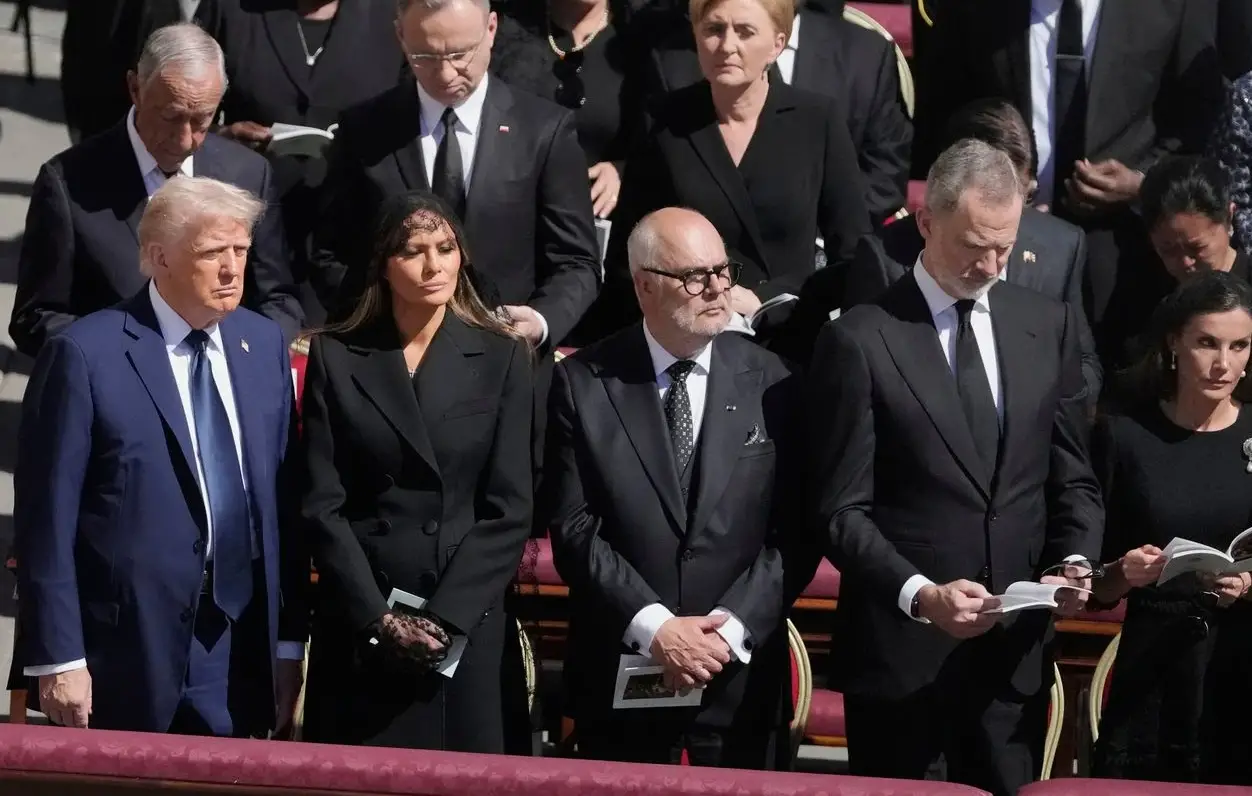The world was watching as the funeral of Pope Francis took place on April 26, 2025, in Vatican City. It was an occasion of immense significance, honoring the life of one of the most influential spiritual leaders of our time. However, amidst the dignitaries and leaders who gathered to pay their respects, former U.S. President Donald Trump once again found himself at the center of controversy.
From his choice of attire to his seating arrangement, Trump’s actions at the funeral did not go unnoticed. The event, which was marked by simplicity and humility in accordance with the late Pope’s wishes, became overshadowed by the former president’s presence, leading to widespread criticism. This article explores the unfolding controversy and the impact of Trump’s actions on this solemn occasion.
The Importance of Pope Francis’ Funeral
Pope Francis, who passed away on Easter Monday, April 21, 2025, left behind a legacy rooted in compassion, peace, and advocacy for the marginalized. As the 266th Pope of the Catholic Church, he had been a global symbol of unity and moral leadership. His funeral was not only a religious ceremony but also a gathering of international figures from all walks of life, from heads of state to humble citizens, all coming together to honor his life and work.
In his final moments, Pope Francis chose a simple and understated funeral, emphasizing the need for humility and reflection. The event was intended to serve as a tribute to his message of peace and his lifelong commitment to those in need. But as the world witnessed this historical moment, Donald Trump’s behavior, from his choice of clothing to his interactions during the service, became a focal point of discussion, overshadowing the somber nature of the event.
The Blue Suit Controversy: A Break from Tradition
One of the most discussed elements of Trump’s appearance was his choice of attire. While nearly all of the other attendees, including foreign dignitaries and heads of state, adhered to the traditional black attire worn at funerals, Trump opted for a blue suit. In the eyes of many, this decision was an unusual and questionable one, especially given the occasion.
Funerals, particularly those in the Catholic tradition, are steeped in symbolism, and attire plays a crucial role in signaling respect and mourning. The color black has long been associated with death and mourning, a visual cue that signifies a period of respect for the deceased. By choosing a blue suit, Trump’s departure from this time-honored practice raised eyebrows.
Social media quickly became a platform for debate. “Why is Trump wearing a blue suit to the Pope’s funeral? No class,” one Twitter user wrote. Others followed suit, expressing their disapproval. “Trump stands out in a blue suit while everyone else is in black. No respect,” said another. These reactions reflected a sentiment shared by many who believed that Trump’s choice of attire was not only a breach of tradition but also an indication of his inability to respect the norms of solemn occasions.
While some might argue that attire is a personal choice, for many, the act of choosing a blue suit for such an important event was seen as a glaring disregard for the traditions and the gravitas of the occasion. It was a move that seemed to elevate the individual above the collective, drawing attention to Trump himself rather than the solemnity of the funeral.
A History of Tension with Pope Francis
The relationship between Donald Trump and Pope Francis has been fraught with tension since 2016. During Trump’s presidential campaign, Pope Francis famously criticized Trump’s stance on immigration, particularly his proposal to build a wall along the U.S.-Mexico border. The Pope stated, “A person who thinks only about building walls, wherever they may be, and not building bridges, is not Christian.” Trump, never one to shy away from confrontation, responded sharply, calling the Pope’s remarks “disgraceful.” He also remarked, “If and when the Vatican is attacked by ISIS, which as everyone knows is ISIS’s ultimate trophy, I can promise you that the Pope would have only wished and prayed that Donald Trump would have been President because this would not have happened.”
This clash was a defining moment in their relationship, showcasing the stark ideological differences between the two figures. Pope Francis championed inclusivity, compassion, and unity, while Trump’s policies and rhetoric often emphasized nationalism and divisiveness. Their ongoing differences, particularly over immigration, were a recurring theme throughout Trump’s presidency, and this tension seemed to spill over into the funeral.
Seating Arrangements: A Political Statement?
Another point of contention during Trump’s attendance at Pope Francis’ funeral was his seating arrangement. At such events, seating arrangements are often carefully curated to reflect a sense of hierarchy, with dignitaries and leaders placed in positions of prominence. The Vatican, known for its strict protocol, typically reserves the front rows for Catholic royals and world leaders of particular standing.
Trump, however, was reportedly seated in what was described as a “third-tier” position, a noticeable step down from the front-row placements of leaders like Prince William and Ukrainian President Volodymyr Zelenskyy. While seating arrangements are typically a reflection of diplomatic and cultural protocol, some observers speculated that this placement was a subtle signal of the strained relationship between Trump and the Vatican.
The incident reminded many of Trump’s previous remarks about seating at other high-profile events. For example, in 2022, Trump mocked President Joe Biden’s seating at Queen Elizabeth’s funeral, criticizing his position in the 14th row. Trump, in typical fashion, remarked, “If I were president, they wouldn’t have sat me back there – and our country would be much different than it is right now.” Ironically, in this case, Trump found himself in a similar position, fueling speculation about the political undertones of the seating decision.
The Aftermath: Reactions from the Public
Following the funeral, the debate over Trump’s actions only intensified. Many commentators and social media users criticized him for attempting to make the event about himself rather than the late Pope. “Trump needs to learn that not everything is about him. A funeral is a time for respect, not for showing off,” one Twitter user wrote. Others felt that his blue suit and third-tier seating were deliberate efforts to stand out and attract attention, a characteristic that has defined much of Trump’s public life.
On the other hand, Trump’s supporters were quick to defend him. They argued that his attire was simply a matter of personal choice, and that he should not be judged for not adhering to tradition. “Trump is a man of confidence, and he shouldn’t be judged for being himself,” one supporter stated. For many, the criticism was seen as another example of the media and political elites unfairly targeting the former president.
This division of opinion reflected the broader polarization of Trump’s legacy. Whether one loves him or hates him, it’s clear that his actions, even in the context of a solemn event like Pope Francis’ funeral, continue to spark debate and stir emotions.
A Legacy of Controversy
Donald Trump’s presence at Pope Francis’ funeral has added another chapter to his long and controversial legacy. His behavior, whether intentional or not, highlighted the ongoing tension between his brand of political populism and the more traditional, diplomatic norms of global events. From his contentious relationship with the Pope to his decision to wear a blue suit, Trump’s actions continued to reinforce his reputation as a figure who commands attention—whether for better or for worse.
For some, the criticism of Trump’s actions at the funeral was a reminder of his disregard for tradition and decorum. For others, it was simply another example of a man who refuses to be bound by the expectations of others. Either way, his presence at Pope Francis’ funeral has ensured that the former president remains a central figure in political and cultural discourse, and his actions at such events are unlikely to be forgotten any time soon.
Conclusion
Donald Trump’s appearance at Pope Francis’ funeral has raised a number of questions about his respect for tradition, his relationship with the Vatican, and his ability to navigate significant international events with the required decorum. Whether his actions were intentional or simply the result of personal preference, they have undeniably sparked conversation. Trump, as always, remains a divisive figure, and his legacy continues to be shaped by his actions—both in and out of the spotlight.
As the world reflects on the life and death of Pope Francis, it is clear that Donald Trump’s involvement in the funeral has once again reminded us of the complex intersection of politics, personality, and global events. Whether praised or criticized, Trump’s actions at the funeral have once again placed him at the center of public debate, ensuring that his legacy will continue to be a topic of conversation for years to come.

Adrian Hawthorne is a celebrated author and dedicated archivist who finds inspiration in the hidden stories of the past. Educated at Oxford, he now works at the National Archives, where preserving history fuels his evocative writing. Balancing archival precision with creative storytelling, Adrian founded the Hawthorne Institute of Literary Arts to mentor emerging writers and honor the timeless art of narrative.
